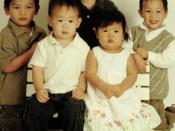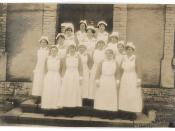�PAGE � �PAGE �5� Family Health Nursing
DOCVARIABLE SH5SectionTitle
Family Health Nursing
Leslie Chambers
University of Phoenix
NUR 464
June 11, 2007
�
DOCVARIABLE SH5SectionTitleFamily Health Nursing
Family health nursing, which is synonymous with family-centered care, is one approach to providing nursing care. Along with describing family health nursing, the importance of family, the changes that family has undergone, and what constitutes family in today's society will be discussed. A personal definition of family health nursing will also be provided.
Description of Family Health Nursing
What is family health nursing? Actions the nurse performs on behalf of the family while attending to the family's unique situation (Meiers, 2002). Family health is a dynamic state created by aspects of the family system's experience which are or may be influenced by the health status of a family member; it incorporates both wellness and illness in interaction with the environment (Meiers, 2002). Family health nursing is also referred to as family-centered care and can be defined as a way of caring for families within health services which ensures that care is planned around the whole family, not just the individual person, and in which all the family members are recognized as care recipients (Shields, 2007).
Patient- and family-centered care is an innovative approach to the planning, delivery and evaluation of health care that is grounded in mutually beneficial partnerships among health care patients, families, and providers. Patient- and family-centered care applies to patients of all ages, and it may be practiced in any health care setting.
The core concepts of family centered care are:
Dignity and Respect. Health care practitioners listen to and honor patient and family perspectives and choices. Patient and family knowledge, values, beliefs and cultural backgrounds are incorporated into the planning and delivery of care.
Information Sharing. Health care practitioners communicate and share complete and unbiased information with patients and families in ways that are affirming and useful. Patients and families receive timely, complete, and accurate information in order to effectively participate in care and decision-making.
Participation. Patients and families are encouraged and supported in participating in care and decision-making at the level they choose.
Collaboration. Patients and families are also included on an institution-wide basis. Health care leaders collaborate with patients and families in policy and program development, implementation, and evaluation; in health care facility design; and in professional education, as well as in the delivery of care (The Institute for Family-Centered Care, 2007).
When providing family health nursing or family centered care the nurse must incorporate the whole family into the care being provided.
Importance of Family
The word "family" refers to two or more persons who are related in any way-biologically, legally, or emotionally. Patients and families define their families (The Institute for Family-Centered Care, 2007). The importance of family varies with each individual based on the individual's background and personal needs.
In the patient- and family-centered approach, the definition of family, as well as the degree of the family's involvement in health care, is determined by the patient, provided that he or she is developmentally mature and competent to do so. The term "family-centered" is in no way intended to remove control from patients who are competent to make decisions concerning their own health care. In pediatrics, particularly with infants and young children, family members are defined by the patient's parents or guardians (The Institute for Family-Centered Care, 2007).
Changes in Family
"Family" has undergone many changes. In the past a family was considered to be a man and woman living together within the confines of marriage and their biological or adopted children. This is not only accepted definition of family anymore. The critical changes in the family structure for the last 40 years have been definitely unconventional. They are: various forms of family structure, tendency to get married late, decreased marriage rate, increased divorce and remarriage rate, common law marriages, homosexual couples, in vitro fertilization, and adoption. Moreover, there are social families distinguished from blood-related families that emerged as a result of adopted children, in vitro babies as a result of advanced technology, and international marriages due to global population movement and so on (Byung & Cho, 2004).
Today's Family
. In today's culture, family can no longer be defined as a married man and woman along with any children associated with that union. A family may consist of two adults of the same gender and their biological or adopted children, a man and woman living together outside the boundaries of marriage and any biological or adopted children, a single man or woman and his/her biological or adopted children. Family may also consist of a group of adults who have no legal or biological relationship but have formed close emotional ties and consider themselves a family.
My Definition of Family Health Nursing
Family health nursing or family-centered care and is caring for the whole family. A nurse must provide for the physical, psychosocial, and spiritual needs of the patient and he or she must also provide for the psychosocial and spiritual needs of the patient's family members. When a patient is in the Critical Care Unit of a hospital the patient's family is also ill. What do I mean by this? If I only administer to the needs of the patient lying in the bed then I am not providing optimal nursing care. The family's psychosocial needs must also be provided for. I have found that if I am able to assist the various family members in understanding the equipment, medications, and treatments that are being used then they are less stressed and able to cope with their loved one's illness. This in turn helps the patient because the stress level has decreased and his or her family can concentrate on providing for the patients individual emotional or spiritual needs.
Conclusion
Family health nursing, which is synonymous with family-centered care, are the actions the nurse performs on behalf of the family while attending to the family's unique situation (Meiers, 2002). Family health nursing is a way of caring for families within health services which ensures that care is planned around the whole family, not just the individual person, and in which all the family members are recognized as care recipients (Shields, 2007).The core concepts of family centered care are dignity and respect, information sharing, participation, and collaboration (The Institute for Family-Centered Care, 2007).
Despite the changes that "family" has undergone, it remains an important part of an individual person. In today's culture, a family is determined by the individual. It can no longer be defined by people connected through legal or biological ties alone. In some instances an individual may determine his or her family based on the emotional ties that bind them to another individual or group in addition to the people who he or she is bound to legally and biologically.
In conclusion, family health nursing is the care that provides for the physical, psychosocial, and spiritual needs of the patient and he or she must also provides for the psychosocial and spiritual needs of the patient's family members.
�
References
DOCVARIABLE SH5SectionTitleByung, H., & Cho, E. (2004). Study of Changes in Family Structure and the Prospective Goals for Family Laws [Electronic version]. Women's studies forum, 20, 105. Retrieved June 10, 2007, from ProQuest Database: http://proquest.umi.com/pqdweb?index=34&did=791863651&SrchMode=1&sid=15&Fmt=3&VInst=PROD&VType=PQD&RQT=309&VName=PQD&TS=1181612225&clientId=2606
Meiers, S. (2002). Family-nurse co-construction of meaning: Caring in the family health experience. [Electronic version]. Retrieved June 7, 2007, from ProQuest Database: http://proquest.umi.com/pqdweb?index=9&sid=3&srchmode=1&vinst=PROD&fmt=6&startpage=-1&clientid=2606&vname=PQD&RQT=309&did=726389071&scaling=FULL&ts=1181594914&vtype=PQD&rqt=309&TS=1181594949&clientId=2606
Shields, L. (2007). Family-Centered care in the perioperative area: An international perspective [Electronic version]. AORN, 85(5), 893 - 902. Retrieved June 11, 2007, from ProQuest Database: http://proquest.umi.com/pqdweb?index=0&did=1270321971&SrchMode=1&sid=10&Fmt=6&VInst=PROD&VType=PQD&RQT=309&VName=PQD&TS=1181605310&clientId=2606
The Institute for Family-Centered Care. (2007). The institute for family-centered care: FAQ. [Electronic version]. Retrieved June 10, 2007, from The Institute for Family-Centered Care website: http://familycenteredcare.org/faq.html



Family care
I totally agree the importance of family in our lives so that I think family health care is really important to a family. What I mean is keeping a family healthy can guarantee all family members live in a happy and joyful life, it's the most important thing in everyone's life!!!
2 out of 3 people found this comment useful.